Seating along with related physical arrangements creates the foundation for meetings, programs and trainings. Often called room setups, they encompass comfort, access and safety for the attendants, and when selected appropriately, extend a presenter's influence in the room, broadcast intention and eliminates distractions.
When thinking about the learning environment, good trainers must consider many variables including seating arrangements. Having the proper seating arrangement can impact everything from group dynamics to comfort and visibility. Hopefully you instruct in a setting where the seating can be modified to enhance the learning environment (KROEHNERT 2007). However, there are some situations, for instance a computer lab, where you may not be able to do any alternations.
However, for those who have the luxury of arranging the seating, the following list provides some scenarios you might encounter in the classroom, and may influence decisions when it comes to making seating arrangements.
- Distance usually reduces participation (e.g. learners sitting the back of the class are less likely to participate than those sitting in the front).
- Arranging the seating in any type of row has a tendency to limit interaction.
- Friends or co-workers attending the same training will usually sit together.
- Difficult learners usually sit as far away from the instructor as possible.
Seating setups fall into two broad categories: large groups (generally over 40) and small groups (usually under 40) (WALLACE 2002).
The most commonly used, but not always the most appropriate, style of seating for large groups is theatre style. Other options are classroom and c chevron styles.
Theatre St
| |
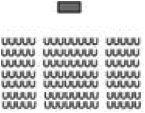 | Accommodates the most people per area. About 10-13 square feet per person. Appropriate for lectures and keynoters. Note taking cumbersome for audience |
Classroom Style | |
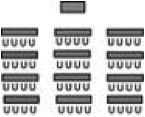 | Same as theatre style but with tables. About 17-20 square feet per person. Supports note taking and use of handout materials. |
Chevron Style | |
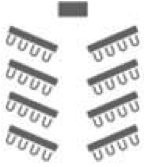 | Provides place for beverages and elbows. Most interactive of large group setups. Promotes a sense of participation. About 20-23 square feet per person. Can be setup with or without tables. |
Modified Chevron | |
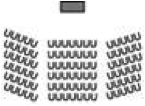 | Can be setup with or without tables. Improves visibility of speaker and visuals from side sections. More interactive than Theatre or Classroom |
Different possibilities of arranging seats for large groups. Source: WALLACE (2002)
All the small group setups (perpendicular, U-shape, semi-circle, hollow square or rectangle, boardroom, cluster and chevron) provide for and encourage the audience to take an active role in the presentation/meeting and to communicate with their peers.
Large group setups, such as theatre or classroom, are sometimes used for small group presentations without realising they create a formal, impersonal atmosphere that may work against the learning goals and objectives of the program and can present serious problems in learning environments requiring audience-to-audience interaction such as discussions, problem solving, or honest feedback. When an audience is able to make eye contact with other members, as in chevron style, the audience builds a sense of community and group learning occurs. Small group works setups are ideal for planning/strategy meetings, focus groups, information sharing, status reports and introduction of new ideas.
Hollow Square or Rectangle | |
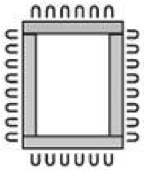 | For meetings where hierarchy is not an issue. Excellent for facilitator led meetings. Encourages audience participation. Awkward to use any visuals. |
Boardroom | |
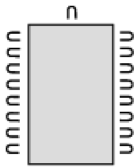 | Very good for groups between 6 and 15. Suggests formality and hierarchy. Over 15, people at the far end table may feel left out and form a separate group |
Perpendicular Style | |
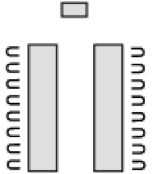 | Seats can be on either outside or inside of tables. Instructor can survey students' work. Easy exchange between presenter and audience. Centre usable for exhibits or demos |
U-Shape | |
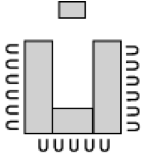 | Encourages collaboration. Centre area usable for simulations and role plays. Can be used with or without speaker table |
Semi-circle or Circle | |
 | Can be setup with or without tables. Presenter's role is minimal. Excellent for emotional sessions such as discussions. Encourages a sense of group and bonding. |
Cluster Style | |
 | Good if students have to do many group works. Clusters easily return to being a single group. Quick and easy to follow with a meal. Tables can be either round or small rectangles. Needs a lot of space. |
Different possibilities of arranging seats for small groups. Source: WALLACE (2002)
Seating arrangements for conferences or training sessions help boost the efficiency and effectiveness of the sessions. Selecting the right seating arrangement that will support the presenter and theme of the training session is very important.
Basic Training for Trainers
Guide on the Side - Room Setups for Presentations & Training - One Size Does NOT Fit All
A practical guide on the importance of room setups.
WALLACE, M. (2002): Guide on the Side - Room Setups for Presentations & Training - One Size Does NOT Fit All. California : Law and technology resource legal professionals URL [Visita: 13.05.2010]Guide on the Side - Room Setups for Presentations & Training - One Size Does NOT Fit All
A practical guide on the importance of room setups.
WALLACE, M. (2002): Guide on the Side - Room Setups for Presentations & Training - One Size Does NOT Fit All. California : Law and technology resource legal professionals URL [Visita: 13.05.2010]Training Infrastructure Specifications
http://www.tesolonline.com/
Some people might think it is not so important where and how students sit in the classroom. This guide explains that it very well is – and explains more about seating arrangement.
http://www.nwlink.com/
This site describes different seating arrangements and their respective advantages and disadvantages.
http://www.howtodothings.com/
Another website that describes different seating arrangements with their respective advantages and disadvantages.
http://www.sales-meeting-ideas.com/
A blog – generally on sales marketing. This specific entry explains why it is important to give some thought to seating arrangements prior to a meeting.

